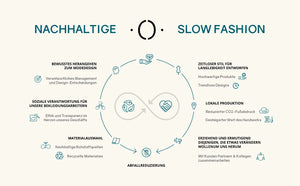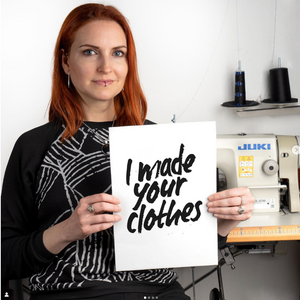Sustainability

Our commitment to sustainability: ethics, responsibility & transparency.
As a slow fashion brand, we focus on sustainability through ethics and transparency. We strive for environmental and social responsibility in the fashion industry by reducing environmental impact and ensuring ethical standards in the production process. Our aim is to promote conscious and responsible consumption and support a sustainable slow fashion model.

Social and ecological responsibility.
We make all our products by hand in Berlin to minimize our carbon footprint while ensuring social and ethical responsibility towards our garment workers. Through local and centralized production, we create an environment of trust and transparency that ensures safety standards and fair wages for all involved. Our production guarantees complete trust and avoids any form of exploitation.

CO2 reduction
We know that the transportation of garments generates a large amount of CO2, which can be reduced by minimizing distances during production, and all the textiles we use in our collection come from European Union countries such as Italy, the Netherlands and Greece. Our main textile partner uses fibers from sustainable sources in Austria.
Alternate your wardrobe
- If you wear the same items of clothing several times a week, they will naturally wear out more quickly. To make your clothes last longer, you should get into the habit of alternating your items.
- It is not advisable to wear the same clothes every day as a uniform, unless they have been specially designed and manufactured for this purpose, such as work clothes.
- If you are totally in love with a garment and want to wear it often, it may make sense to buy two of the same item that you like so that one can rest while the other is worn. Having multiple garments of the same style may cost more initially, but both pieces will last longer.
- Also take off your outerwear when you get home and make sure you choose the right clothes for each activity.
Freshen up your clothes between uses.
- This extends the time between washes and increases the life of your clothes.
- Hang up your clothes to air out.
- Wipe or dab the garments to remove dirt and dust.
Washing
- People tend to wash their clothes too often. Every time you wash and dry your clothes, small pieces of fabric come off, which leads to a lot of wear and tear. If you wash your clothes less often, they will last longer. If your clothes are not visibly dirty or smelly, you should wear them at least three times before washing them.
- The best way to wash a garment and prolong its life is to hand wash or use the gentle cycle with cold water.
- Always read and follow the washing instructions. Not only will your clothes look good, they will also last longer.
- Sort the laundry according to similar washing instructions and colors to reduce the number of washes, prevent colors from fading and avoid accidentally ruining light-colored clothes.
- New items of clothing, such as dark clothing, should be washed separately the first time so that the colors do not bleed.
- Turn the garments inside out when washing and close the zippers to reduce pilling on the visible side and avoid accidental tearing.
- Do not load the washing machine with too many items. Your clothes won't get as clean and the constant friction can ruin the surface.
- Use a mesh bag to protect delicate items of clothing. These are not only useful for delicate and small items of clothing, but also for sweaters and much more. With a mesh bag, the garments stay clean and keep their shape.
- Reduce the amount of detergent. This is better for your clothes and the environment. Be careful with fabric softeners. Although they can make clothes appear softer and smell good, they can also be harmful.
Drying
- Use a clothes horse to air dry your clothes instead of using the dryer, which is harmful to your clothes. The hot air weakens, fades the colors and shrinks the materials. This is especially true for stretchy fabrics.
Dry cleaning
- Try to avoid dry cleaning. This uses chemicals that can damage the fabric of your clothes and also has an unnecessary impact on the environment.
Pre-treat your clothes
- Try to treat stains immediately to prevent them from setting. It's handy to have a stain remover pen with you to treat stains immediately and remove them easily later.
- Pre-treat your clothes to remove stains and fix other problems before you put them in the wash. Although this takes extra time and effort, it prevents you from having to wash your clothes several times, which could ruin them.
- Once you have put the garment in the washing machine, check whether the stain has come out. Continue to treat the stain and wash the garment again until the stain is removed. Do not put the garment in the dryer as the stain may set due to the heat.
Storage
- Store your clothes correctly and with care.
- Some items of clothing are best stored folded. Sweaters and knitwear will dent and stretch over time if they are stored on hangers. Fold them and store them on a shelf or in a drawer so that they keep their shape.
- Use the right size and type of hanger for your garments so that the neck, shoulders and collar are not overstretched and your clothes retain their shape better.
- Keep your closets dry to prevent moisture and mold from building up in them. Make sure your clothes are completely dry before you put them away.
- Leave space between the garments to allow air to circulate.
Repair
- Learn to do some repairs yourself, for example mending small holes or replacing buttons. However, if you don't feel confident enough, you should take your garment to a seamstress.
Keep using your clothes
- Old items of clothing can be reused to find a new purpose. Garments with small stains or wear and tear can become pyjamas, loungewear, garden clothing or clothes for thorough house cleaning.

Love your clothes and make them last.
Small changes in behaviour can help to minimize the environmental impact of our clothing. Our vision is a world where the clothes we wear only spread love.









